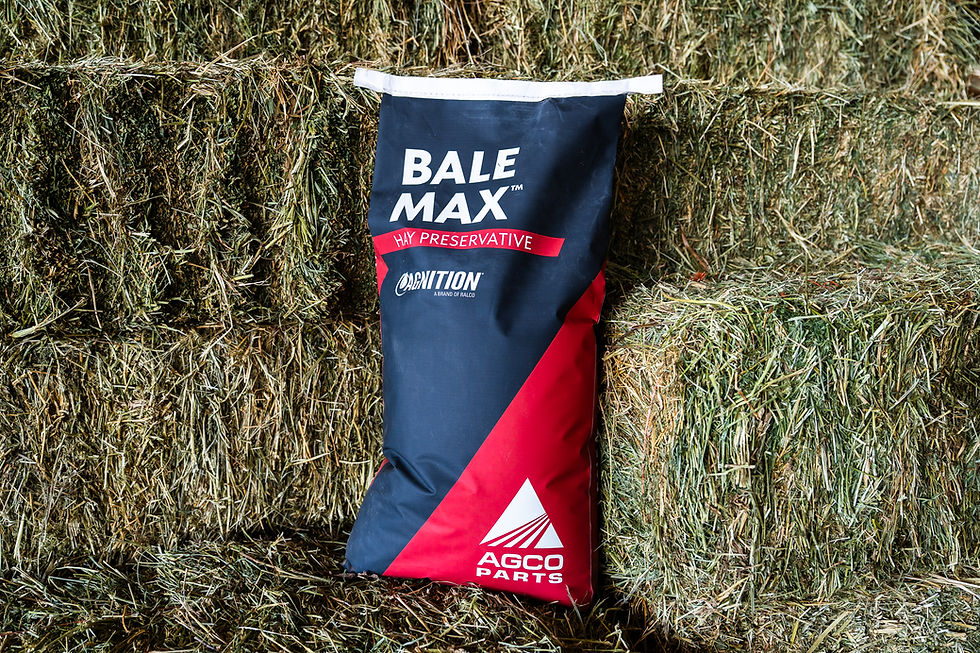Preserve Quality of Higher Moisture Hay
- Agnition
- Apr 20, 2020
- 3 min read
Updated: May 19, 2020
Bryant Dorn remembers the days when he baled hay until dawn. Excess moisture in recent years put a stop to the Montana farmer’s all-nighters.
With dairy and cattle producers across the country counting on his family’s farm to provide them with quality forage, Dorn was determined to find a way to extend the baling window. In 2018, his family began applying Anchor™ for Hay as they square baled more than 3,500 acres of alfalfa.
“We use this as insurance. It preserves the quality, prevents rot and lets us push the moisture limit,” he says of the hay preservative that reduces risk of heating and spoilage, allowing producers to bale higher moisture hay. “If it saves a couple bales, it pays for itself.”
Quality matters. Depending on the year and the markets, the family’s hay business accounts for a large portion of the farm’s overall income. In addition to raising commercial alfalfa, Dorn, his dad and brother also raise cattle, sugar beets, corn and barley near Hardin.
“Before, we would always have a lumpy, mold spot in at least a few bales. Now, we don’t see rot in our bales,” Dorn says. “Because it’s granular, we don’t worry about it rusting our balers.”
Hay baled at higher moisture levels reduces the risk of leaf loss. In alfalfa, the leaves contain 70 percent of the plant’s protein and 90 percent of its vitamins. A long-term hay trial in Minnesota showed bales treated with Agnition’s hay preservative, cured faster and maintained relative feed value 30 points higher than control.
Prevent spoilage in high moisture hay
Several moisture-related factors impact hay quality. This hay preservative mitigates these factors through two modes of action: organic acid and Microbial Catalyst® technology plus inoculant.

Together, these modes of action preserve hay quality by:
Reducing temperatures in higher moisture hay by rapidly decreasing pH levels. This limits growth of mold, yeast and other harmful bacteria.
Cutting cure time to help bales cool off faster to further maintain quality of higher moisture hay.
Decreasing dry matter loss, producing higher-quality bales with less sagging.
Being able to bale in higher moisture conditions, while at the same time preserving hay quality are the reasons Todd Mangin began using the hay preservative in 2015.
“Every time it gets rained on, hay loses feed value and quality. This year a lot of neighbors were fighting mold in hay. I didn’t have a problem,” explains the Gettysburg, South Dakota, cow/calf producer. “I also notice a difference in hay quality. The hay is just green. You don’t get those tobacco spots in the alfalfa. And the cows are more apt to clean it up.”
In addition to alfalfa, last summer Mangin also applied the product while baling millet. He was waiting for it to dry down when five days of rain were forecast. “It was a case where we either bale it or we were not going to get it.”
Mangin baled it at 20 to 30 percent moisture. “It maintained its quality. Also, it doesn’t heat up in bales or a pile,” explains Mangin who grinds 60 percent of his hay.

(Anchor for Hay comparison photo taken in Gettysburg, South Dakota)
The product can also be utilized when baling corn stalks. To learn more about applicator options and application rates call 1-855-832-0613 or visit Agnition.
About Agnition
Agnition is a brand of Ralco, a third-generation, family-owned multinational company with distribution in more than 40 countries. Ralco is a leading global supplier of livestock nutrition, animal health products and crop enhancement technologies that support large segments of the livestock, poultry, aquaculture and crop production industries.
For more information contact:
Glenn Bader
(507) 337-6867




Comments